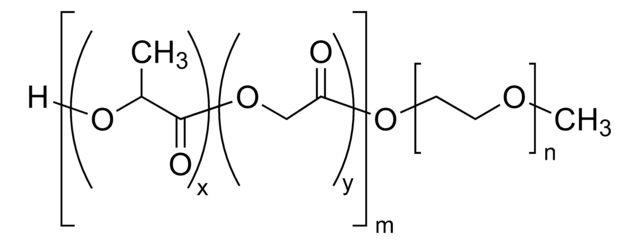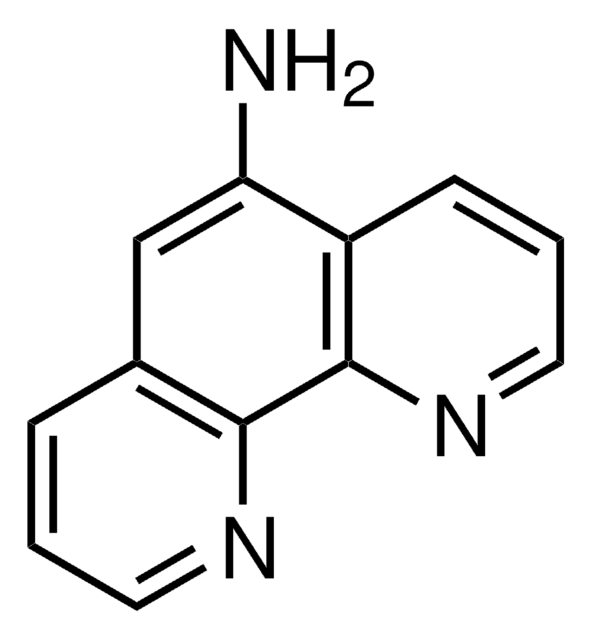911399
Poly(ethylene glycol) methyl ether-block-poly(lactide-co-glycolide)
PEG average Mn 2,000, PLGA average Mn 10,000, lactide:glycolide 80:20
동의어(들):
PEG-PLGA, PEG2K-PLGA10K, mPEG-b-PLGA
로그인조직 및 계약 가격 보기
모든 사진(2)
About This Item
Linear Formula:
H[(C3H4O2)x(C2H2O2)y]mO[C2H4O]nCH3
UNSPSC 코드:
12352112
NACRES:
NA.23
추천 제품
Quality Level
형태
powder or chunks
피드(feed) 비율
lactide:glycolide 80:20
분자량
PEG average Mn 2,000 (by NMR)
PLGA average Mn 10,000 (by NMR)
색상
off-white to faint brown
저장 온도
−20°C
유사한 제품을 찾으십니까? 방문 제품 비교 안내
애플리케이션
This polymer is a amphiphilic diblock copolymer composed of a hydrophilic PEG block and a hydrophobic PLGA block. This biodegradable, biocompatible polymers can self-assemble to form nanoparticles, such as micelles and polymersomes, in both aqueous and non-aqueous media. Due to these properties, these polymers are widely used in polymeric nanoparticle formulation to achieve controlled and targeted delivery of therapeutic agents (e.g. APIs, genetic material, peptides, vaccines, and antibiotics). Additionally, well-defined nanoparticles with tunable size and properties can be prepared by altering the molecular weight ratios between hydrophilic and hydrophobic blocks, as well as by controlling formulation parameters.
Storage Class Code
11 - Combustible Solids
WGK
WGK 3
Flash Point (°F)
Not applicable
Flash Point (°C)
Not applicable
가장 최신 버전 중 하나를 선택하세요:
Fabienne Danhier et al.
Journal of controlled release : official journal of the Controlled Release Society, 133(1), 11-17 (2008-10-28)
The purpose of this study was to develop Cremophor EL-free nanoparticles loaded with Paclitaxel (PTX), intended to be intravenously administered, able to improve the therapeutic index of the drug and devoid of the adverse effects of Cremophor EL. PTX-loaded PEGylated
Miles A Miller et al.
Nature communications, 6, 8692-8692 (2015-10-28)
Therapeutic nanoparticles (TNPs) aim to deliver drugs more safely and effectively to cancers, yet clinical results have been unpredictable owing to limited in vivo understanding. Here we use single-cell imaging of intratumoral TNP pharmacokinetics and pharmacodynamics to better comprehend their
Yihan Xu et al.
Journal of biomedical materials research. Part B, Applied biomaterials, 105(6), 1692-1716 (2016-04-22)
Poly (lactic-co-glycolic acid) (PLGA) copolymers have been broadly used in controlled drug release applications. Because these polymers are biodegradable, they provide an attractive option for drug delivery vehicles. There are a variety of material, processing, and physiological factors that impact
R Gref et al.
Science (New York, N.Y.), 263(5153), 1600-1603 (1994-03-18)
Injectable nanoparticulate carriers have important potential applications such as site-specific drug delivery or medical imaging. Conventional carriers, however, cannot generally be used because they are eliminated by the reticulo-endothelial system within seconds or minutes after intravenous injection. To address these
자사의 과학자팀은 생명 과학, 재료 과학, 화학 합성, 크로마토그래피, 분석 및 기타 많은 영역을 포함한 모든 과학 분야에 경험이 있습니다..
고객지원팀으로 연락바랍니다.





